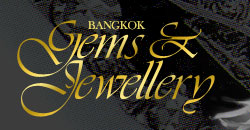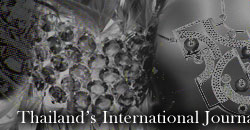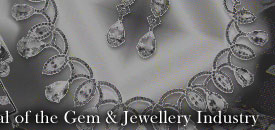| |
| |
It's true, peridot does have extra terrestrial origins. Many small
crystallities of peridots have been found in ironand nickel rich
meteorities called pallasites that had crashed into the Earth's
surface in ancient times and some have been faceted and used as
gems as well. Recently, early this year, scientists have also discovered
the presence of peridot on the surface of Mars.
The terrestrial specimens of peridots have
very violent origins, born as they are literally out of fire and
flames of volcanic anger spewed out of the bowels of the Earth in
a magnificent display of nature's temper tantrums. The natives of
Hawaii even revered it as Goddess Pele 's (Goddess of Volcanoes)
tears. However, funnily enough even though the island of Oahu has
grains of olivine (the base mineral of peridot), mixed in the sands
of its beaches, most of the peridot sold in Hawaii actually comes
from Arizona. |
|
|
|
Arizona is the largest source of peridot and at one time accounted
for as much as 80% - 90% of the world's supply. It is mined by Native
Americans on the San Carlos Apache Indian Reservation in Arizona,
known to be the most productive peridot locality in the world. As
the deposits are on Indianlands, only they have the right to mine
it.
Then in 1994, an exciting
new deposit of the gem was found in Pakistan at a site that is 15,000
feet above sea level in Nanga Parbat region of the Himalayas in
Pakistan Occupied Kashmir. These Pakistani stones are among the
finest specimens of the gem ever to be seen and the mountains yield
beautiful large crystals unlike the small material that typically
comes from the Arizona mines. One of the stones recovered from Nanga
Parbat was more than 300 carats in size. |
|
|
|
The largest faceted peridot weighs 310 carats and is displayed at
the Smithsonian Institute's Museum of Natural History in Washington
D.C. A 192.75 carat stone belonging to the Russian Czars is in the
diamond treasury in Moscow, while a 146 carat specimen is displayed
in the Geological Museum in London. What makes these specimens rare
is that peridot is generally found in the smaller sizes and stones
that are larger than 20 carats are not at all common.
Today the various sources
of peridot include Zabargad Island in the Red Sea off the coast
of Egypt, Mogok in Myanmar, Minas Gerais in Brazil, Eifel in Germany,
Chihuahua in Mexico, Norway , South Africa, China, Kenya, Tanzania,
Ethiopia, Australia and Salt Lake Crater in Hawaii besides Arizona
and Pakistan as mentioned earlier. |
|
|
|
Zabargad Island is the oldest recorded source of peridot and was
written about by Pliny in 1500 B.C. Mining was carried out at night
as legend had it that it could not be seen easily during the day
and was only apparent in the hours between "light of day and
darkness of night". Miners would search for the stones with
no more than the light of single candle each. It is said that the
island was infested with venomous snakes, which made peridot mining
an extremely hazardous occupation until on Pharoah had all the snakes
killed and restricted traffic to and from the island. The miners
were not allowed to leave the island and since in those times, peridot
was valued far more than we do diamonds today, anybody who approached
the island unexpectedly was killed on slight.
Peridot has been continually mined on Zabargad
for centuries. Till before World War I, it was extensively mined
and produced millions of dollars of gems. Then in 1958, the miners
were nationalised and currently, there is hardly much activity there,
although from time to time, it does still yield some beautiful specimens.
Peridot from the Zabargad mine has been
found in ancient Greek and Roman ruins as well. In fact, the Romans
had a name for it, they called it the Evening Emerald because its
colour remained true even in fading light. It is true that in ages
past, peridot has often been mistaken for emeralds even though the
two gems sport entirely different shades of the colour green.
|
|
|
|
It is speculated that most of Cleopatra's famous emeralds were in
fact, peridot. Similarly, quite a bit of ancient emerald jewellery
from royal treasures, when reassessed in modern times have been
found to contain peridot rather than the precious green gem. At
one time, it was even called topazion or topazos though subsequently
that name was bestowed on the gem we know today as topaz. It was
also known as chrysolite from the ancient "chrysolithos"
meaning golden stone.
This confusion may strike us as funny today
because as we know, the green of emeralds is a dark one and does
not have the distinct yellow component that marks peridot. However,
we must remember that gemology is a modern science and in centuries
past, it was quite common that one gem material be mistaken for
another like spinel and ruby for instance.
Peridot's colour spectrum includes shades
like lime green or olive green and is described as ranging from
a light summery yellowish green to the green colour of a 7-UP bottle.
The green colour of peridot, which is a form of the mineral olivine,
depends on the presence of ferrous iron present in the stone. It
is said that the best coloured peridot has an iron percentage of
less than 15% and includes nickel and chromium as trace elements
that may also contribute to the best peridot colour.
|
|
|
|
As mentioned, peridot is the gem variety
of olivine, which cannot exactlybe classified as an official mineral
as it is actually composed of two main minerals fayalite and forsterite,
as well as other less well known ones. Olivines are isoorphous,
meaning they have the same crystal structure, with varying chemical
compositions. Although peridot depends on ferrous iron for its colour,
nevertheless its chemical composition is closer to forsterite than
fayalite.
The name peridot itself was and old trade
term of unknown origin used by French jewellers and introduced to
gemology by J.R. Hauy. Some speculate that it comes from the French
peritot meaning unclear, and probably refers to the presence of
inclusions in the larger stones. Though clear peridots are easily
found in the smaller sizes of less than 5 carats, once they cross
this size, they are more likely to be included. Others believe that
the name can be traced to the Arabic word faridat, which means gem.
Still others point out that it is mentioned in the Bible by the
Hebrew word pitdah. The Biblical reference alludes to the presence
of peridot on the breastplate of the Jewish High Priest. The breastplate
was said to be set with twelve gemstones to represent the twelve
tribes of Israel. As the twelve gems on the breastplate of the Jewish
High Priest were said to represent the twelve birthstones, peridot
is the birthstone for the month of August. It is necessary to point
out that the breastplate has never been found and could well be
as mythical as Noah's Ark. The Egyptians of course kept it simple
and just called it the gem of light. |
|
|
|
Due to its volcanic
origins, most peridot is found in igneous rocks. Unlike most other
gemstones, it is highly suseptible to chemical weathering and thus
does not survive very long at the surface in wet climates. This
fact probably explains the restricted number of gem localities where
it is found and its predominance in arid and semi arid parts of
the globe.
Because of the way in which peridot bends
the rays of light passing through it, it has a velvety appearance,
a rich glow and a slightly greasy lustre. It is fairly dense with
a special gravity ranging from 3.27 - 3.37. Peridot crystallises
in the ortherhombic system, there are three crystallographic axes
all perpendicular to each other but of varying lengths. Orthorhombic
crystals also have two non-crystallographic axes along which light
travels at fixed velocities. These are called optic axes and since
there are two, orthorhombic crystals are said to be biaxial. The
refractive indexes of peridot range from 1.654 to 1.690. Peridot
has three refractive indexes, two of which remain fixed and one
that is variable and numerically between the upper and lower index.
The birefringence (the numerical difference between the highest
and lowest refractive indexes) is fairly high for peridot at 0.036. |
|
|
|
What this
means in layman's terms is that when a beam of light enters peridots,
it is bent and slowed down such an extent that whenever is viewed
through the crystal is seen as a split image. Why this is important
is that when a jeweller looks at a faceted peridot through the table
of the stone, the junctions of the adjacent facets seem to be strongly
doubled. Common substitutes for peridot are synthetic sapphire and
synthetic spinel and since both of them are isotropic (have only
one display this doubling feature. Glass has also been used as a
peridot substitute but it will show bubbles and no doubling.
Peridot's hardness is
6.5 on the Moh's scale which makes it a not very hard or durable
gem, although its toughness does range from fair to good. It can
be damaged by rapid or uneven heat, which may cause fracturing in
the em. It is also attacked by sulphuric acid and to a lesser extent
by hydrochloric acid as well. In fact, even something as innocuous
as perspiration can cause damage to the stone. Therefore the best
way to clean peridot jewellery is with warm soapy water. Ultrasonics
are not recommended and steam cleaning should never ever be used. |
|
|
|
|
|
|
|





